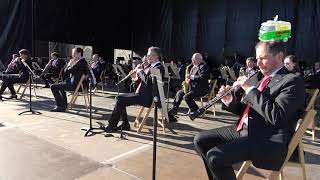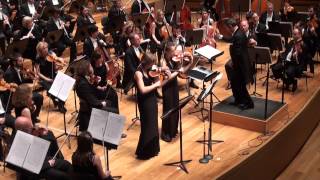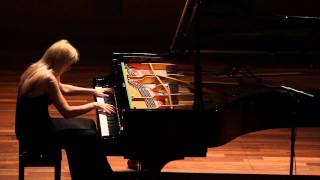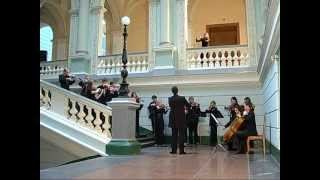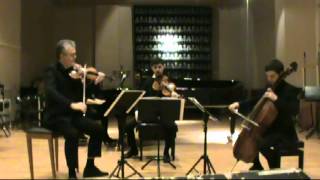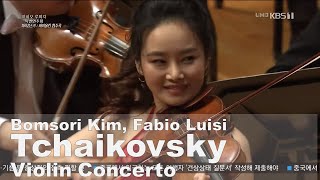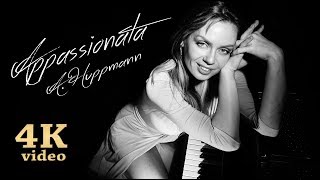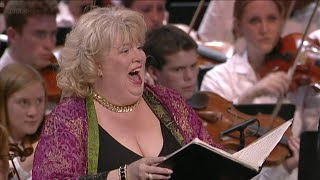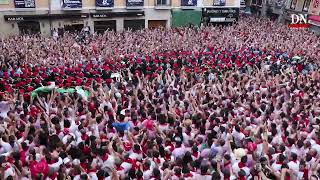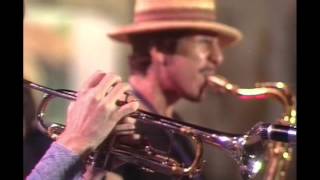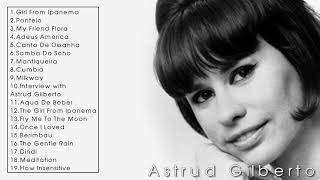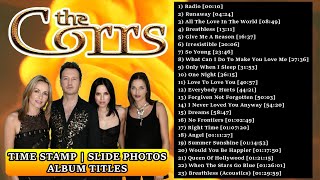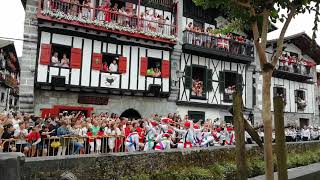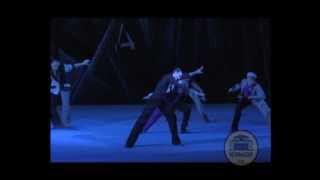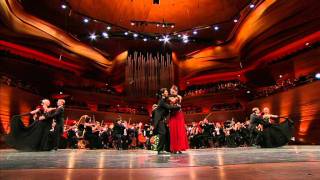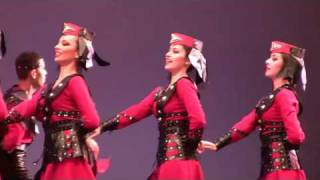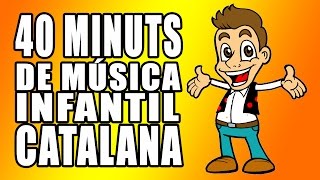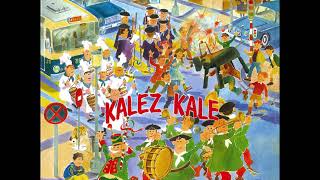At 12 noon on July 6 the Fiestas de San Fermín begin
Recommended music videos for initiation to classical music
Biribilketa Kalejira, Pasacalles, Martxa, Martxea, Karrikadantza, Basque March ... many names to express a single reality: the meaning of these terms is very common: a light march, normally written in 6/8 time (but sometimes in 2/4). The phrases are square, sixteen bars long, although they often consist of eight repeated bars, generally with an antecedent and consequent structure. In general, they meet all the conditions of European scholarly music (Extracted from Auñamendi Eusko Entziklopedia).
Gainza's Biribilketa is the first piece to be performed in the Sanfermines after the Txupinazo in the hall of the Town Hall , performed by La Pamplonesa (the Municipal Band) and the Txistularis from Pamplona and Navarra .
Manuel Gainza . Gipuzkoan musician born in Tolosa on May 18, 1885 and died in Getxo on April 1, 1943. A disciple of Gorriti and Mocoroa , he was also organist of the Sestao parish, and director of the Trabajo y Cultura orfeón and of the Sociedad Coral de Portugalete (1906-1907). His connection to the choral world is also reflected in the founding of the Biotz-Alai Choir [of Algorta/Getxo] in 1926. On the other hand, he composed works for band and for txistu, being the author of various harmonizations. Several of his compositions and arrangements have been published in the magazine Txistulari (Extracted from Auñamendi Eusko Entziklopedia).
Pablo Sarasate (1844-1908) was a composer and violin virtuoso born in Iruña/Pamplona . A precocious child whose parents, aware of their son's musical aptitudes, trained him in the violin studio; studies that he expanded in Madrid and Paris . In 1859 he began his public career giving concerts throughout Europe and America, remaining active until his death. Its universal prestige was evident with the dedication with which eminent composers such as Max Bruch , Camille Saint-Saëns , Édouard Lalo, Henryk Wieniawski , Antonín Dvořák … and some others headed some of his scores. He died at his home in "Villa Navarra" in Biarritz in 1908, at the age of 64.
The Navarrese Jack . As published in the Diario de Navarra (1966) by the writer José María Iribarren : “The Navarrese jota began to permeate the Navarrese soul in the cholera epidemic of the year 1885. The city of Tafall has its medicine in the jota; next to the sulfur bonfires, there are the rondallas to temper the spirits. In this way, the jota becomes consubstantial with Navarra , and especially, with La Ribera . To all this, Manuel García Matos adds: “La Jota Navarra is closely related to the Aragonese ; but it presents a greater linear undulation of the phrases, with more abundant and long melismas, and is not subject to its metric regularity. It has more melodic preciosity than the Aragonese and the introduction and instrumental variations are also different”.
Navarra is a Navarre jota written by Sarasate for two violins and orchestra that is performed today by Matjaž Bogataj and Oksana Pečeny accompanied by the Gymnasium Kranj Symphony Orchestra conducted by all of them by maestro Primož Zevnik .
Franz Liszt (1811-1886) was a brilliant pianist and successful Hungarian composer, whose works have endured over the years; works for piano solo or concertante, as well as orchestral works among which it is worth highlighting his symphonic poems , the musical form of which he is the progenitor. Liszt 's father, an amateur musician, gave him his first piano lesson at the age of seven. In October and November 1820, at the age of nine, he appeared in concerts in Sopron and Bratislava . His father arranged for Franz to be presented to the Court of the House of Esterházy as a child prodigy. It was famous throughout Europe during the 19th century ; his contemporaries claimed that he was the most technically advanced pianist of his day and the greatest of all time.
Hungarian Rhapsody No. 2 , S. 244/2 is one of Lizt 's nineteen Hungarian Rhapsodies . It offers the pianist the opportunity to display his virtuosity while also attracting a huge audience. The work consists of two different parts: the (0´7´´) LASSAN and the (5´07´´) FRISKA (from the Hungarian: lassú - slow; friss - fresh, fast). It is written in C sharp minor and is dedicated to Count Ladislas Teleky ("au Comte Ladislas Teleky"). It was composed in 1847, and was first published as a solo piano piece in 1851 by Senff and Ricordi . This rhapsody has been used in cartoons, in various movies, and has served as the basis for several popular songs.
The version that we offer today is performed by Valentina Lisitsa (1973), a Ukrainian pianist who has lived in the USA since 1991. She began studying piano at the age of three, later enrolling in the Kiev Conservatory where she met her husband Alexei Kuznetsoff , also a pianist. Lisitsa has sought out her audience through her own You Tube channel for which she has recorded many performances, currently being the most watched classical soloist on the internet.
Henry Mancini (1924-1994) was a famous American composer, conductor, arranger, pianist, and flutist of film, jazz, and Latin-influenced music. He is noted above all for his work for film and television. He is frequently mentioned as one of the greatest composers in the history of cinema, winner of four Academy Awards ( Oscars ), a Golden Globe and twenty Grammys , as well as a posthumous Grammy for his career in 1995. Among his most important works Recognized are the theme and soundtrack for the television series Peter Gunn , the soundtrack of The Pink Panther (for which he won a Grammy ) and his collaboration in the Blake Edwards comedies, in which the song Moon River (from Breakfast at Tiffany's , 1961), which we offer today.
" Moon River " (Moon River) is a composition by Henry Mancini that won the Oscar for best original song of that year. It was composed expressly by Henry Mancini for Audrey Hepburn for her role in the film Breakfast at Tiffany's and the following year it won the Grammy Award for Record of the Year. Today we offer it in a flute version accompanied by a string ensemble with Khrystyna Andrukhiv as soloist.
Recommended classical music videos
Fernando Remacha Villar (1898-1984), born in Tudela , was probably the most important Navarrese composer of the 20th century . He started violin studies in Tudela and later in Pamplona . He later moved to Madrid , where he attended violin classes with José del Hierro and composition classes with Conrado del Campo . In 1923 he won the Rome Prize , a scholarship that allowed him to move and study there with Gian Francesco Malipiero . In 1928 he returned to Madrid and obtained a viola position in the Arbós Symphony Orchestra through competitive examination and also took charge of putting music to several films by José Luis Sáenz de Heredia or Luis Buñuel . In 1930 he became one of the most representative musicians of the Generation of '27 . In 1957 he started the Pablo Sarasate Conservatory in Pamplona .
Chamber music is music composed for a small group of instruments, as opposed to orchestral music . The name comes from the small rooms, or chambers , in which small groups of musicians rehearsed during the Middle Ages and the Renaissance . Little by little , chamber music began to spread in small concert halls and in private homes. A fact induced by the access of the bourgeoisie to instrumental practice and because, economically, a chamber ensemble was much more profitable than an orchestra. There are two details that allow us to fully characterize a chamber work: 1) each musician plays a different part and 2) there is no conductor; the musicians should be situated so that they can face each other, to achieve the best coordination.
Piano Quartet . It is a quartet written for violin, viola, cello and piano with which Remacha won in 1932 the first of the three National Music Awards that he would receive during his lifetime. It is structured in three movements: I (0´00´´) ALLEGRO MODERATO .-. II (10:00) ANDANTE .-. III (16:48) ALLEGRO VIVO and today we are updated by Ricardo Odriozola violin, Uzeyir Makhmudbaily viola, Georgy Imanov cello and Signe Bakke piano.
Piotr Tchaikovsky (1840-1893) was a Russian composer who graduated from the Saint Petersburg Conservatory and wrote works of different genres, although he achieved his greatest success with his ballets. In 1859 he obtained a position as a civil servant in the Ministry of Justice , which he would abandon at the age of three to be able to dedicate himself solely to music. His personal life was plagued by continuous crises since the death of his mother and his repressed homosexuality, which forced him into a marriage that only lasted a few months. He wrote more than 150 compositions, including piano works, quartets, suites, symphonies, concertos, chorales, cantatas, operas, and ballets. He died at the age of 53 and is considered one of the greatest composers in history.
The Concerto is a musical form written for one or more solo instruments accompanied by an instrumental ensemble. It was Vivaldi who established the fundamental bases of its structure with three movements ( I fast-II slow-III fast ) and presented as a dialogue between the soloists and the instrumental ensemble. Beginning with classicism (1750-1810), especially from the bases created by CPE Bach , the first movement is built following the patterns of the sonata form (exposition, development and re-exposition) , while the second and third movements adopt free and punctual forms. Frequently, at the end of the first and/or third movement, the soloists have a cadence without orchestral accompaniment with which they can show off their virtuosity.
Tchaikovsky's Violin Concerto , one of the most renowned and difficult violin concertos to perform, leaves two indelible impressions: the inherent virtuosity of its creation and the beauty of its melodies. THE FIRST MOVEMENT (0´05´´) Allegro moderato begins with a brief introduction, lyrical in nature, followed by the melodies that make up the rest of the movement. THE SECOND MOVEMENT (18´32´´) Canzonetta: Andante . It begins with a passage in chords executed by the woodwinds and the horns, which give way to a traditional Russian melody of a calm character that serves as a bridge without pause to the THIRD MOVEMENT (24'40'') Allegro vivacissimo , inspired by developed Russian themes. through multiple variations in orchestration, rhythm and melody.
Ludwig van Beethoven (1770-1827) together with Bach and Mozart is part of the trio of giants of Western music. Born in Bonn , his father, of Flemish origin, tried to make a second Mozart of him, though it was a notable failure. Despite this, from the age of nine, the organist Christian Gottlob Neefe captivated him with the study of Bach , whom he would always keep in mind. In 1787 he moved to Vienna with the intention of receiving Mozart classes, but the death of his mother brought him back to Bonn after a few days. And so after five years, he returned to Vienna where he made contact with Haydn and Salieri , making himself known as a composer and pianist with well-known public recognition. However, his profession as a pianist could not be carried out due to the deafness that attacked him the following year until he was totally disabled from said faculty.
Beethoven 's musical legacy includes 32 piano sonatas, numerous works for chamber ensembles, concertos for piano and violin, incidental music, sacred music and, above all, nine symphonies that occupy the zenith of the History of Music . This legacy, to understand it better, we can divide it into three stages of continuous renewal and improvement: A) Until 1802 , Classicism . His first ten piano sonatas, the first six string quartets, the septimino, the first two symphonies or the first two piano concertos belong to him. B) 1803-1815 . romanticism . In full artistic maturity and with absolute control of the formal structure and lyricism, he composes the symphonies from the 3rd to the 8th, his opera Fidelio , his 3rd, 4th and 5th piano concertos, the violin concerto, the triple concerto, the sonatas for piano “Moonlight”, “Appasionata” , the Kreutzer Violin Sonata ,… C) 1815 until his death . Innovation of a more intense language with more daring harmonic and structural treatments: the last five piano sonatas and the last five string quartets, Symphony No. 9 with the addition of soloists and choir, Solemn Mass ...
Piano Sonata No. 23 in F minor op. 57 by Ludwig van Beethoven , known as the Appassionata (passionate), was composed in Döbling , a town near Vienna , in 1804. The Appassionata was so nicknamed by the publisher, which angered Beethoven , who believed that all his works were written to touch each other passionately and not only this one. The Appassionata consists of three movements: I (0´00´´) ALLEGRO ASSAI .-. II (10´35´´) ANDANTE WITH MOTO-attacca .-. III (16´41´´) ALLEGRO, MA NON TROPPO-PRESTO. Today it is offered to us by the Russian pianist Anastasia Huppmann (1988), who has obtained important first prizes in numerous Russian and European competitions and collaborated with famous orchestras in Europe and Asia .
Gustav Mahler (1860-1911) was an Austrian composer and conductor born in Kaliště , present-day Czechia , regarded as one of the most eminent composers of Post-Romanticism. His creative work focused on the symphony, the lied (lyric song) and the conjunction of both concepts; to this must be added the diversity of elements with which he worked (popular, military melodies, fanfares of various kinds...) the manifest dissonances to which the public was not accustomed and the long duration of his symphonies; If we add to this that he faced a certain anti-Semitic press due to his Jewish origins, it is not surprising that his compositions did not have the success they deserved in life.
Gustav Mahler 's Symphony No. 8 in E flat major is one of the largest-scale choral works in the classical orchestral repertoire. Because it requires such a large number of instrumentalists and choralists, it is often referred to as the "Symphony of a Thousand", although the work is often performed with fewer than a thousand players and Mahler himself did not approve of such a nickname. The piece was composed in a single period of inspiration, in Maiernigg (village) in southern Austria in the summer of 1906. It was the last work that Mahler premiered while he was alive, and it enjoyed great critical and public acclaim when he conducted it in the world premiere in Munich , on September 12, 1910.
The structure of the work is not conventional. Instead of following the normal multi-movement structure, the work is divided into two parts. The FIRST PART (1'48'') is based on the Latin text of a ninth-century Christian hymn for Pentecost , Veni Creator Spiritus ("Come, Creator Spirit"), and the SECOND PART (26'43'') is an arrangement of the words from the final scene of Goethe 's Faust . Today it is offered to us by the unforgettable American composer and conductor Leonard Bernstein (1918-1990) conducting the Vienna Philharmonic Orchestra, the Vienna State Opera Chorus, the Vienna Children's Choir, Edda Moser (soprano), Judith Blegen ( soprano), Gerti Zeumer (soprano), Ingrid Mayr (alto), Agnes Baltsa (alto), Kenneth Riegel (tenor), Hermann Prey (baritone) and Jose Van Dam (bass).
Recommended music videos for all tastes
The Fiestas de San Fermín , popularly known as Sanfermines , are a Festival of International Tourist Interest in honor of San Fermín de Amiens , which takes place annually in Iruña/Pamplona, the capital of Nafarroa/Navarre , of which it is co-patron. The festivities begin with the launch of the chupinazo from the balcony of the Town Hall , at 12 noon on July 6, and end at midnight on July 14 with Poor Me..., the farewell song.
Horace Silver (1928-2014) was an American jazz pianist and composer. He is one of the pioneering musicians of hard bop in the fifties, and one of the most popular and influential artists in the contemporary jazz mainstream thanks to his smooth, imaginative and very funky style. He also worked within Fusion . Silver was one of the most influential jazz musicians of his day. Grove Music Online describes his legacy as at least fourfold: 1) as a hard bop pioneer; 2) as a user of what became the archetypal quintet instrumentation of tenor sax, trumpet, piano, bass, and drums; 3) as a promoter of young musicians who went on to become important actors and bandleaders; and 4) for his skill as a composer and arranger.
Astrud Gilberto (1940) is a Brazilian music and jazz singer. With a German father and a Brazilian mother, her maiden name was Astrud Weinert , a surname that she changed at the age of 19 when she married João Gilberto , who brought her closer to the world of music. Tom Jobim 's song The Girl from Ipanema elevated him to the top of the Brazilian singers of the time, making himself known throughout the world in what would be a successful musical career.
The Corrs is an Irish band made up of four brothers and sisters who play everything from traditional Irish music to pop and rock . Throughout their career they have sold more than 50 million records; between 1996 and 2001 they obtained 60 platinum records and have toured extensively in Asia, America and Europe , having been awarded as members of the Order of the British Empire and also obtained a Billboard award, a British Award , two Grammy Award nominations and the special mention of the Ondas Award jury.
Recommended peculiar videos
Lesakako Zubigaineko dantza (The Dance on the Lesaka Bridge) is one of the most popular dances in the Basque Country . Coinciding with the festival of San Fermín , on July 7, the espatadantzaris of Lesaka dance the Zubigain (“Over the Bridge”) on the parapet of the Onin river bank. It is a great day for the Lesakarras; and for those who dance the Zubigain , undoubtedly the most emotional moment of the party. It seems that this dance is a memory of the peace pact between the neighborhoods of this town in the fifteenth century . However, outside of history, some specialists have seen it closely related to the rituals of the solstice of San Juan . In reality, it may be a ritual stemming from different traditions. It is noteworthy that on the day of San Fermín 2019 , for the first time in history, three women acted as swordsmen after several years of rehearsals.
The Golden Age (the golden age) op. 22, is a ballet in three acts and six scenes by Dmitri Shostakovich with a libretto by Alexander Ivanovsky and choreography by Vasili Vainonen (act one), Leonid Jacobson (act two) and V. Chesnakov (act three). The ballet is a satirical version of the political and cultural change in Europe in the twenties with a Soviet soccer team in a western city, where he comes into contact with many politically incorrect antagonistic characters such as the Diva, the Fascist , Agent Provocateur , Black and others. Victims of police harassment, the team is wrongfully imprisoned and is released from jail when local workers overthrow their capitalist masters. Shostakovich himself was a great football fan and is said to have coined the expression "Football is the ballet of the masses".
The Viennese waltz (in German, Wiener Walzer ) is one of the dance styles within ballroom dancing ; It is a rotating dance where the dancers are constantly turning to the leader's right (natural) or to the left (reverse), interspersed with non-rotating change steps to change the direction of rotation. A true Viennese waltz consists only of turns and change steps. Furthermore, in a properly danced Viennese waltz , the couples do not pass, but instead continually turn from left to right as they travel counterclockwise around the floor, following one another.
Wiener Blut (Viennese Blood) is an operetta in three acts with music by Johann Strauss (Jr.). It receives its name from the homonymous waltz by Johann , because the popularity of the original waltz, "Viennese Blood", was such that his work would be chosen as the title of the operetta set around the time of the Congress of Vienna from 1814 to 1815.
The Armenian Dance appears in cave paintings from 5,000 years BC; scenes of country dances are supposed to be accompanied by musical instruments or songs. Already in the fifth century, Moses of Khoren recounts how the ancient Armenians used the lyre and its songs for dancing. Currently, each region continues to have its own dances with their exclusive costumes; dances that tell us the stories, customs and traditions of their people, from ceremonial dances to war dances.
Vanoush Khanamirian (1927-2011) was a famous Armenian dancer and choreographer who founded the school that bears his name and that we have before us today with one of its traditional dances.
Recommended music videos for children
Various Wikipedia articles have been used to write these texts.
The texts of Videomusicalis are written in Basque, Spanish and English.





